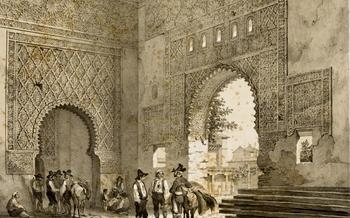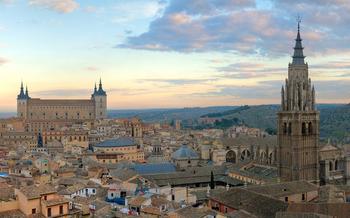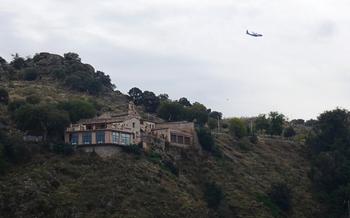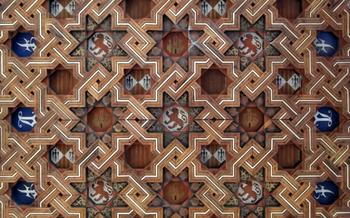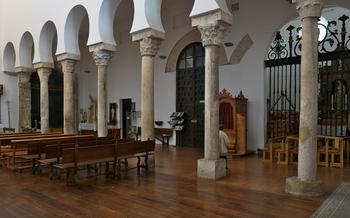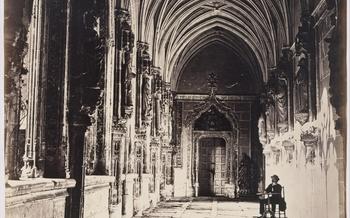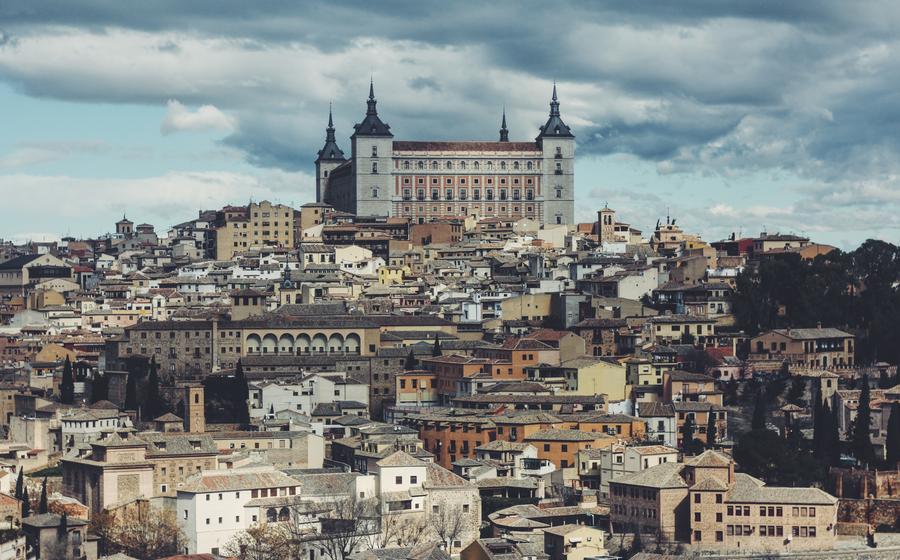
The Alcántara Gate and Roman bridge
- The Alcántara Gate: A Timeless Masterpiece
- Crossing the Roman Bridge: A Journey Through Time
- The Puerta del Sol: A Gateway to Enchanting Views
- The Jewish Quarter: A Journey into the Past
- The Cathedral of Toledo: A Majestic Symbol of Faith
- The Alcázar of Toledo: A Fortress of Kings
- The Museo del Greco: A Journey into Artistic Brilliance
- The Mirador del Valle: A Breathtaking Panorama
- The Monasterio de San Juan de los Reyes: A Gothic Masterpiece
- Plaza de Zocodover: The Heart of Toledo
- Museo Sefardí: Preserving Jewish History and Culture
- The Cristo de la Luz Mosque: A Fusion of Cultures
- Insider Tip: Explore the City at Night
The Alcántara Gate: A Timeless Masterpiece
Toledo's Alcántara Gate, a testament to the city's rich and storied past, stands as a majestic symbol of architectural prowess and historical significance. Built in the 16th century by the renowned architect Alonso de Covarrubias, the gate served as the city's main entrance and a vital defense point. Its imposing structure, adorned with intricate carvings and sculptures, reflects the city's opulent past and its enduring legacy.
The gate's design is a testament to the fusion of Renaissance and Gothic styles, with its elegant arches, intricate stonework, and decorative elements. The gate features two towers, one on each side, which once housed the city's guards and provided a vantage point for surveillance and defense. The gate's exterior is adorned with elaborate carvings depicting scenes from mythology and history, showcasing the artistic mastery of the era.
Beyond its architectural grandeur, the Alcántara Gate played a pivotal role in the city's defense. Its strategic location allowed for the control and regulation of access to the city, serving as a protective barrier against potential invaders. The gate's sturdy construction and ingenious design provided a formidable defense, ensuring the safety and security of Toledo's citizens.
Over the centuries, the Alcántara Gate has witnessed countless historical events and witnessed the passage of kings, armies, and pilgrims. It has endured sieges, battles, and the passage of time, standing as a silent sentinel of the city's rich tapestry of history. Today, the gate serves as a popular tourist attraction, inviting visitors to step back in time and experience the grandeur and majesty of Toledo's past.
Crossing the Roman Bridge: A Journey Through Time
The Roman bridge, known as Puente de Alcántara, is an awe-inspiring feat of ancient engineering that spans the Tagus River and connects the historic city center of Toledo with the suburb of Antequeruela. Its construction dates back to the 1st century AD, during the reign of Emperor Augustus, and it stands as a testament to the enduring legacy of Roman craftsmanship.
The bridge's remarkable longevity and resilience are attributed to its innovative design and sturdy construction. Its 5 arches, each spanning over 30 meters, were built using large granite blocks, fitted together with precision without the use of mortar. This architectural prowess has allowed the bridge to withstand the relentless flow of the Tagus River and the passage of time, becoming an enduring symbol of Toledo's rich history.
Throughout the centuries, the Roman bridge has served as a vital connection point, facilitating trade, travel, and cultural exchange between Toledo and the surrounding region. It played a strategic role in the defense of the city, allowing for the swift movement of troops and supplies. Its enduring strength and resilience have made it a beloved landmark, admired by locals and visitors alike.
As you stroll across the Roman bridge, marvel at the picturesque views that unfold before you. The shimmering waters of the Tagus River, the lush greenery of the surrounding countryside, and the majestic skyline of Toledo create a breathtaking panorama that will forever etch itself in your memory.
The Puerta del Sol: A Gateway to Enchanting Views
A short distance from the Alcántara Gate, discover the Puerta del Sol, another captivating landmark of Toledo. This 14th-century gate was once part of the city's defensive system, strategically positioned on the eastern side. As you approach the gate, admire its imposing structure, featuring a horseshoe-shaped arch and fortified towers. Its name, Puerta del Sol, translates to "Gate of the Sun," an allusion to its orientation towards the rising sun.
Once you step through the gate, prepare to be mesmerized by the breathtaking panorama that unfolds before you. The city of Toledo, with its iconic monuments and winding streets, stretches out before your eyes, creating a picture-perfect postcard moment. The views from this vantage point are simply stunning, offering a unique perspective of the city's grandeur.
The Puerta del Sol holds cultural and historical significance as well. It served as the main entrance for travelers and merchants entering the city from the east, contributing to Toledo's vibrant trade and cultural exchange. Over the centuries, it has witnessed countless arrivals and departures, each carrying stories of journeys and encounters.
As you stand beneath the arch of the Puerta del Sol, take a moment to soak in the beauty of the surrounding cityscape and imagine the stories that these ancient walls could tell. Whether you're a history buff, a photography enthusiast, or simply someone who appreciates breathtaking views, this gate is a must-visit destination in Toledo.
The Jewish Quarter: A Journey into the Past
Toledo's Jewish Quarter, also known as the Judería, is a captivating labyrinth of narrow cobblestone streets, evocative plazas, and hidden courtyards that transport visitors back in time. Once home to a thriving Jewish community, the quarter retains its unique atmosphere and architectural heritage, offering a glimpse into the city's rich and diverse past.
The history of the Jewish community in Toledo dates back to the Middle Ages when the city was a center of learning and commerce. Jews played a vital role in the city's economy and contributed significantly to its cultural and intellectual life. The quarter was a vibrant hub of Jewish culture, with synagogues, schools, and communal institutions flourishing within its walls.
As you wander through the picturesque streets of the Judería, you'll encounter remnants of this rich history. The beautifully preserved synagogues, such as the Sinagoga del Tránsito and the Sinagoga de Santa María la Blanca, stand as testaments to the architectural prowess and artistic achievements of the Jewish community. These stunning edifices, with their intricate carvings, colorful tilework, and elegant arches, offer a glimpse into the spiritual and cultural life of Toledo's Jewish inhabitants.
The Jewish Quarter is not merely a collection of historical landmarks; it's a living, breathing neighborhood that exudes a palpable sense of history. The narrow streets are lined with charming shops, galleries, and restaurants, many of which are run by descendants of the original Jewish families. Here, you can savor the flavors of traditional Sephardic cuisine, browse for unique handicrafts, and immerse yourself in the vibrant atmosphere of a community that has proudly preserved its heritage.
The Jewish Quarter is a place where the past and present intertwine, where the echoes of history resonate in the lively streets and the spirit of the Jewish community lives on. It's a must-visit destination for anyone interested in exploring the rich cultural tapestry of Toledo and gaining a deeper understanding of its diverse history.
The Cathedral of Toledo: A Majestic Symbol of Faith
Toledo's awe-inspiring cathedral, known as the Catedral Primada, stands as a testament to the city's rich religious and cultural heritage. Its construction, spanning nearly three centuries from the 13th to the 16th century, reflects the dedication and artistry of generations of master builders. The cathedral's Gothic architecture, characterized by soaring spires, intricate carvings, and magnificent stained-glass windows, is a sight to behold.
Architectural Splendor and Artistic Treasures
The interior of the cathedral is equally captivating, boasting an array of artistic masterpieces. Among its highlights are the stunning choir stalls, intricately carved from wood and adorned with biblical scenes. The Capilla Mayor, or main chapel, houses a magnificent altarpiece by the renowned Renaissance artist Berruguete, depicting scenes from the life of Christ. The cathedral also showcases a collection of priceless paintings by El Greco, whose works can be admired in the sacristy and other chapels.
A Center of Pilgrimage and Faith
Beyond its architectural and artistic splendor, the Toledo Cathedral holds immense religious significance. It is the seat of the Archbishop of Toledo, Primate of Spain, and has served as a center of pilgrimage for centuries. Pilgrims from far and wide flock to the cathedral to venerate its sacred relics, including the remains of Saint Eugene, the city's patron saint.
Legends and Mysteries
The Cathedral of Toledo is steeped in legends and mysteries that add to its allure. One captivating tale tells of a hidden treasure buried beneath the cathedral, guarded by a mysterious entity known as the "Duende de la Catedral." Another legend recounts the story of a secret tunnel connecting the cathedral to the Alcázar, used by the monarchs of Castile to escape in times of danger.
A Must-See for History and Art Enthusiasts
Whether you're a history buff, an art enthusiast, or simply seeking spiritual inspiration, the Toledo Cathedral is a must-visit destination. Its grandeur, artistic treasures, and centuries of history make it one of the most iconic landmarks in Spain, leaving an indelible mark on every visitor.
The Alcázar of Toledo: A Fortress of Kings
In the heart of Toledo, overlooking the city and the Tagus River, stands the Alcázar, an imposing fortress that has witnessed centuries of history. Built on the site of a former Roman palace, the Alcázar served as a royal residence, a military stronghold, and a prison during the Spanish Inquisition.
Its strategic location made it a crucial defensive point, and its massive walls, towers, and moat protected the city from countless attacks. The Alcázar's impressive fortifications, including the Torre del Homenaje, the Torre de la Vela, and the Puerta de Bisagra, are testaments to its military significance.
Throughout its history, the Alcázar has undergone several renovations and expansions, blending architectural styles from different eras. The current structure, dating mostly from the 16th century, showcases a mix of Gothic, Renaissance, and Mudejar elements. Its grand halls, courtyards, and gardens once hosted royal ceremonies, receptions, and celebrations.
One of the most intriguing aspects of the Alcázar is its role as a prison during the Spanish Inquisition. Its dark dungeons held prisoners accused of heresy and other crimes against the Catholic Church. The Alcázar's association with the Inquisition adds a somber chapter to its history, reminding visitors of the darker periods of Toledo's past.
Today, the Alcázar serves as a museum, showcasing its rich history and architectural heritage. Visitors can explore its halls, admire its impressive collection of weapons and armor, and learn about the pivotal role it played in shaping the destiny of Toledo.
The Museo del Greco: A Journey into Artistic Brilliance
Nestled in the heart of Toledo, the Museo del Greco stands as a testament to the artistic genius of El Greco, a 16th-century painter who left an indelible mark on the city's cultural landscape. Housed within the walls of a former hospital, the museum showcases a remarkable collection of El Greco's masterpieces, providing visitors with an immersive journey into the creative mind of this extraordinary artist.
The museum's collection boasts over 200 paintings by El Greco, spanning various stages of his artistic career. Visitors can marvel at the vibrant colors, expressive brushstrokes, and elongated figures that characterize his unique style. Among the highlights of the collection are "The Burial of Count Orgaz," a monumental work depicting the burial of a nobleman surrounded by a celestial procession, and "View of Toledo," a breathtaking cityscape that captures the essence of the city as seen through the eyes of El Greco.
Beyond the paintings, the museum also offers a glimpse into El Greco's life and creative process. Visitors can explore the artist's studio, where they can see the tools and materials he used to create his masterpieces. The museum also houses a collection of personal belongings, including letters, sketches, and documents that shed light on the artist's personality and influences.
The Mirador del Valle: A Breathtaking Panorama
Perched atop a hill, the Mirador del Valle offers a breathtaking panorama of Toledo, a captivating city steeped in history and architectural wonders. This viewpoint, with its elevated position, provides a unique perspective on the city's skyline, allowing visitors to witness the harmonious blend of ancient and modern architecture.
The Mirador del Valle is not merely a tourist attraction but also a place of historical significance. It was once a strategic military lookout, offering a vantage point for spotting approaching armies or monitoring the surrounding countryside. Today, it serves as a peaceful retreat, inviting visitors to soak in the beauty of Toledo and its picturesque surroundings.
The viewpoint is easily accessible, making it a popular spot for both locals and tourists. Visitors can stroll along the scenic path that leads to the Mirador, enjoying the tranquil atmosphere and the panoramic views that unfold at every turn. Once at the viewpoint, they can relax on the benches provided, marveling at the stunning vista before them.
The Mirador del Valle is especially enchanting at sunset, when the sky transforms into a canvas of vibrant colors, casting a golden glow on the city below. As the sun dips below the horizon, the city lights begin to twinkle, creating a magical and unforgettable ambiance.
Whether you're a history buff, a nature enthusiast, or simply a traveler seeking breathtaking views, the Mirador del Valle promises an unforgettable experience. Don't miss the opportunity to visit this incredible viewpoint and witness the beauty of Toledo from a unique perspective.
The Monasterio de San Juan de los Reyes: A Gothic Masterpiece
The Monasterio de San Juan de los Reyes is a stunning commemorate their victory at the Battle of Toro, the monastery is a testament to their faith and devotion. Its construction spanned several decades, with various architects and craftsmen contributing to its unique design and intricate details.
The exterior of the monastery is a sight to behold, with its elegant stone facade adorned with intricate carvings, delicate tracery, and magnificent buttresses. The main entrance, known as the Puerta del Perdón, is a masterpiece in itself, featuring elaborate sculptures depicting scenes from the Bible and the lives of the saints.
Stepping inside the monastery, visitors are greeted by a breathtaking cloister, surrounded by two-story arcades supported by slender columns. The serene atmosphere and intricate details of the cloister create a sense of tranquility and awe. The central courtyard features a beautiful garden, adding a touch of color and serenity to the space.
The interior of the church is equally impressive, with its soaring vaults, stained-glass windows, and ornate altarpieces. The main altarpiece, carved in alabaster, is a masterpiece of Gothic art, depicting scenes from the life of Christ and the Virgin Mary. The choir stalls, with their intricately carved wooden seats, are another highlight of the church, showcasing the skill and artistry of the craftsmen who worked on the monastery.
The Monasterio de San Juan de los Reyes is not just a religious monument but also a significant historical site. It played a crucial role in the history of Spain, serving as a royal palace, a prison, and a military barracks during different periods. Today, it stands as a testament to the enduring legacy of the Catholic Monarchs and the rich cultural heritage of Toledo.
Plaza de Zocodover: The Heart of Toledo
A vibrant hub of activity, the Plaza de Zocodover is the beating heart of Toledo, a meeting point for locals and visitors alike. Its storied past can be traced back to the 11th century, when it served as a bustling marketplace and a gathering place for merchants and traders. Over the centuries, it has witnessed countless events, from lively market days to bullfights and even executions, and its cobblestones hold stories and secrets from a bygone era.
Today, the square is a vibrant melting pot of cultures, a kaleidoscope of sights and sounds. Street vendors hawk their wares, from traditional crafts to souvenirs, while locals and tourists mingle in the cafés and restaurants that line the plaza, savoring delicious tapas and refreshing drinks. At night, the square transforms into a magical realm, as the buildings are bathed in a warm, golden glow and the air fills with the sounds of music and laughter.
Museo Sefardí: Preserving Jewish History and Culture
A treasure trove of Jewish history and culture awaits discovery within the walls of the Museo Sefardí, a captivating institution dedicated to preserving the rich legacy of Toledo's Jewish community. Journey through time as you explore the museum's collection of artifacts, documents, and exhibits, each narrating a chapter in the vibrant story of Sephardic life in Spain.
Delve into the intricacies of Jewish customs and traditions, gaining insights into the daily lives, religious practices, and cultural contributions of the Sephardic community. Admire exquisite textiles, ceremonial objects, and manuscripts that showcase the artistry and craftsmanship of Jewish artisans.
The museum's exhibits not only illuminate the history of Toledo's Jewish community but also shed light on the broader tapestry of Jewish life in medieval Spain. Discover the contributions of Jewish scholars, philosophers, and merchants who played pivotal roles in shaping the intellectual and economic landscape of their time.
Through interactive displays and multimedia presentations, the Museo Sefardí brings the past to life, creating a vivid and immersive experience for visitors. Engage with the stories of individual Sephardic families, tracing their journeys and struggles as they navigated the changing tides of history.
A visit to the Museo Sefardí is a journey of discovery and remembrance, honoring the enduring legacy of a community that left an indelible mark on the cultural fabric of Toledo and Spain.
The Cristo de la Luz Mosque: A Fusion of Cultures
A hidden gem nestled in the heart of Toledo, the Cristo de la Luz Mosque stands as a testament to the city's rich cultural tapestry. Built in the 10th century during the Islamic period, this mosque represents a harmonious blend of Islamic and Christian architectural styles.
The mosque's exterior boasts intricate brickwork and horseshoe arches, reminiscent of Islamic architecture. Step inside, and you'll be greeted by an awe-inspiring sight: a series of graceful columns topped with intricate capitals, supporting a ceiling adorned with stunning Mudejar-style paintings.
This unique fusion of Islamic and Christian elements reflects Toledo's complex history, where different cultures and religions intersected and influenced each other. The mosque's transformation into a Christian church after the Reconquista further added to its significance, creating a sacred space that embraces both faiths.
As you explore the Cristo de la Luz Mosque, let your imagination wander back to a time when Toledo was a vibrant crossroads of cultures. Imagine the muezzin's call to prayer echoing through the streets, followed by the solemn chanting of Christian hymns. This mosque represents a living testament to Toledo's rich heritage, where different faiths and cultures intertwined, leaving an indelible mark on the city's identity.
Insider Tip: Explore the City at Night
Toledo transforms into a captivating spectacle when the sun sets, offering a completely different perspective of the city. The ancient streets, adorned with soft golden light, create a magical atmosphere that transports visitors back in time. The iconic monuments, such as the Alcázar and the Cathedral, are beautifully illuminated, casting dramatic shadows and exuding an ethereal glow.
Strolling through the narrow cobblestone streets at night is an enchanting experience. The city's rich history comes alive as you pass by centuries-old buildings, each with its own story to tell. The air is filled with the sounds of traditional music and laughter, emanating from the lively bars and restaurants that line the streets.
Toledo's vibrant nightlife offers a diverse range of options for visitors. From traditional Spanish taverns serving delicious tapas to modern cocktail bars with live music, there is something to suit every taste. For those seeking cultural experiences, the city's theaters and concert halls host a variety of performances, from flamenco shows to classical concerts.
One of the highlights of a nocturnal visit to Toledo is the opportunity to capture stunning photographs. The illuminated monuments against the dark sky create a picturesque backdrop for capturing memories of your trip. Remember to bring your camera or smartphone to capture the city's nocturnal beauty.
Exploring Toledo at night is a must-do experience for any traveler. The magical atmosphere, vibrant nightlife, and breathtaking views make it an unforgettable journey through time. So, be sure to include a night-time exploration in your itinerary to fully immerse yourself in the charm and enchantment of this captivating city.

